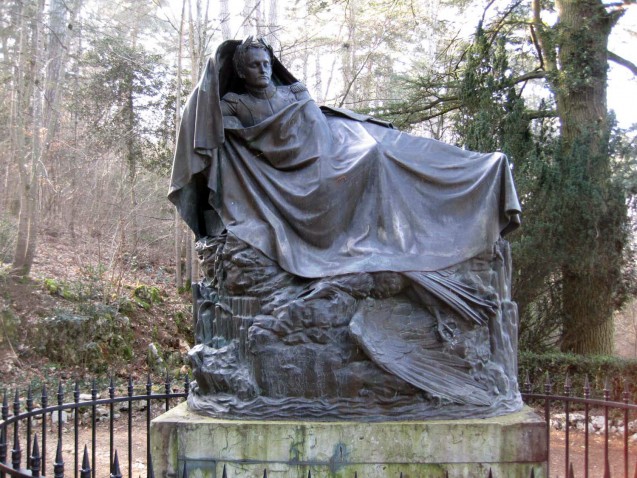This bronze – also known as “Le réveil de Napoléon” (Napoleon awakes) – is by the sculptor François Rude and was commissioned in early 1840 by Claude Noisot, a former grenadier-à-pied and captain of the Old Guard. This military man was a faithful devotee of the Emperor, and had participated in the campaigns in Austria and Spain in 1809, in Russia in 1812, in Germany in 1813 and in the French campaign in 1814. He had insisted on accompanying Napoleon I into exile on Elba and naturally supported the latter’s return during the Hundred Days. Noisot’s military career ended with the defeat of Waterloo but his devotion to the deposed ruler did not. Under the Restoration Claude Noisot became a miniaturist then in 1830 was made commander of the Garde Nationale. In 1835 aged 48, he retired and devoted himself to the creation of a museum and a park dedicated to Napoleon I, including archives and relics from the First Empire. He chose as its location the town of Fixin in the French department of Côte d’Or (Burgundy, France), where he had a replica built of the I Mulini Palace on Elba, to house the collection. Noisot also had a staircase with a hundred steps carved on his land in order to recall the epic of the Hundred Days. The return of the Emperor’s mortal remains in 1840 probably gave Noisot the idea to create a bronze statue bearing the likeness of the Emperor to reinforce the symbolism of his Napoleonic sanctuary.
Rude’s statue is totally unlike works representing the Emperor in a state of sickness, tormented by the boredom of confinement, and it goes against the grain of the usual imagery linked to St. Helena. Napoleon is not dying but dead: moreover he is in a state of resurrection, victorious over death. Unlike other depictions of resurrections such as that of Lazarus in the New Testament or indeed the Last Judgment, this scene has the particularity of being devoid of any Christian symbolism. The statuette is shown in a somewhat abstract context, which does not explicitly evoke the concept of immortality: here Napoleon, whose eyes are still closed by supposedly eternal sleep, is himself the miracle-worker of his own resurrection.
This sculpture also makes reference to the art of Antiquity: Napoleon’s semi-recumbent position is reminiscent of Etruscan sarcophagi. The Eagle (the imperial symbol which lies crushed and half-covered by the shroud that Napoleon is lifting up) and the chain (that seems to have been broken to allow the Emperor to stand up) both echo the myth of Prometheus, the titan who had been punished by Zeus for having stolen the sacred fire from mount Olympus and given it to men and who had been condemned to be chained to the Caucasus mountain and to have his liver eternally devoured by an eagle. Napoleon is here an anti-Prometheus who is releasing himself from captivity. No god, no prison can stop his immortal legend: the eagle, prisoner of St Helena (as depicted in this 1901 advertisement), can now be reborn like the phoenix.
François Rude was likewise expressing in this work his attachment to the Empire. He had been a student at the school of Fine Arts in 1809 and was awarded the Prix de Rome in 1812 before he fled the Restoration and settled in Belgium until 1827, when he returned to Paris. His art was influenced by Neoclassicism as we can see in the mythological inspiration of this work; the posture and the message generated by this bronze nevertheless strongly evoke the emerging Romantic Movement, of which Rude was a pioneer. The statue was inaugurated on 19 September 1847 in the presence of Louis-Napoleon Bonaparte, the future president of the Second Republic and the future Napoleon III. A plaster of this monument is visible in the Musée du Louvre.
Marie de Bruchard, December 2015 (translation, RY)


